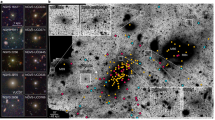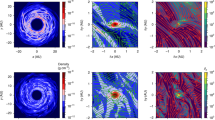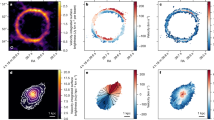Abstract
ZWICKY1 argued long ago that tidal forces can tear long tails of stars and gas from the bodies of interacting disk galaxies, and that this debris may include self-gravitating objects which could become small galaxies. Some recent observations revealing small clumps of stars and gas in tidal tails lend weight to this idea2–4. Here we report the results of numerical simulations of encounters between disk galaxies5, each modelled with a central bulge, an exponential disk and a spheroidal dark-matter halo. We find that dwarf systems form in material drawn out during the encounter; these objects can capture large amounts of moderately enriched gas, but retain little dark matter from their parents' haloes. They should therefore have lower mass-to-light ratios than galaxies formed directly by the collapse of primordial material.
This is a preview of subscription content, access via your institution
Access options
Subscribe to this journal
Receive 51 print issues and online access
$199.00 per year
only $3.90 per issue
Buy this article
- Purchase on Springer Link
- Instant access to full article PDF
Prices may be subject to local taxes which are calculated during checkout
Similar content being viewed by others
References
Zwicky, F. Ergeb. Exakt. Naturwiss. 29, 344–385 (1956).
Schweizer, F. in Structure and Properties of Nearby Galaxies (eds Berkhuijsen, E. M. & Wielebinski, R.) 279–285 (Reidel, Dordrecht, 1978).
Mirabel, I. F., Dottori, H. & Lutz, D. Astr. Astrophys. 256, L19–L22 (1992).
Mirabel, I. F., Lutz, D. & Maza, J. Astr. Astrophys. 243, 367–372 (1991).
Barnes, J. E. & Hernquist, L. E. Astrophys. J. 370, L65–L68 (1991).
Toomre, A. & Toomre, J. Astrophys. J. 178, 623–666 (1972).
Colina, L., Lipari, S. & Macchetto, F. Astrophys. J. 379, 113–121 (1991).
Negroponte, J. & White, S. D. M. Mon. Not. R. astr. Soc. 205, 1009–1029 (1983).
Barnes, J. E. Astrophys. J. 393, 484–507 (1992).
Hernquist, L. & Katz, N. Astrophys. J. Suppl. 64, 419–446 (1989).
Wallin, J. F. Astr. J. 100, 1477–1488 (1990).
Mould, J. in The Astronomy and Astrophysics Encyclopedia (ed. Maran, S. P.) 238–240 (Van Nostrand-Reinhold, New York, 1992).
Toomre, A. in The Structure and Evolution of Normal Galaxies (ed. Fall, S. M. & Lynden-Bell, D.) 111–136 (Reidel, Dordrecht, 1981).
Efstathiou, G. & Eastwood, J. W. Mon. Not. R. astr. Soc. 194, 503–525 (1981).
Davis, M., Efstathiou, G. P. E., Frank, C. S. & White, S. D. M. Astrophys. J. 292, 371–394 (1985).
Gerola, H., Carnevali, P. & Salpeter, E. E. Astrophys. J. 268, L75–L78 (1983).
Elmegreen, B. G., Kaufman, M. & Thomasson, M. Astrophys. J. (submitted).
Author information
Authors and Affiliations
Rights and permissions
About this article
Cite this article
Barnes, J., Hernquist, L. Formation of dwarf galaxies in tidal tails. Nature 360, 715–717 (1992). https://doi.org/10.1038/360715a0
Received:
Accepted:
Issue Date:
DOI: https://doi.org/10.1038/360715a0
This article is cited by
-
Interacting galaxies and mergers
Nature Astronomy (2019)
-
Tidal dwarf galaxies at intermediate redshifts
Astrophysics and Space Science (2012)
Comments
By submitting a comment you agree to abide by our Terms and Community Guidelines. If you find something abusive or that does not comply with our terms or guidelines please flag it as inappropriate.



